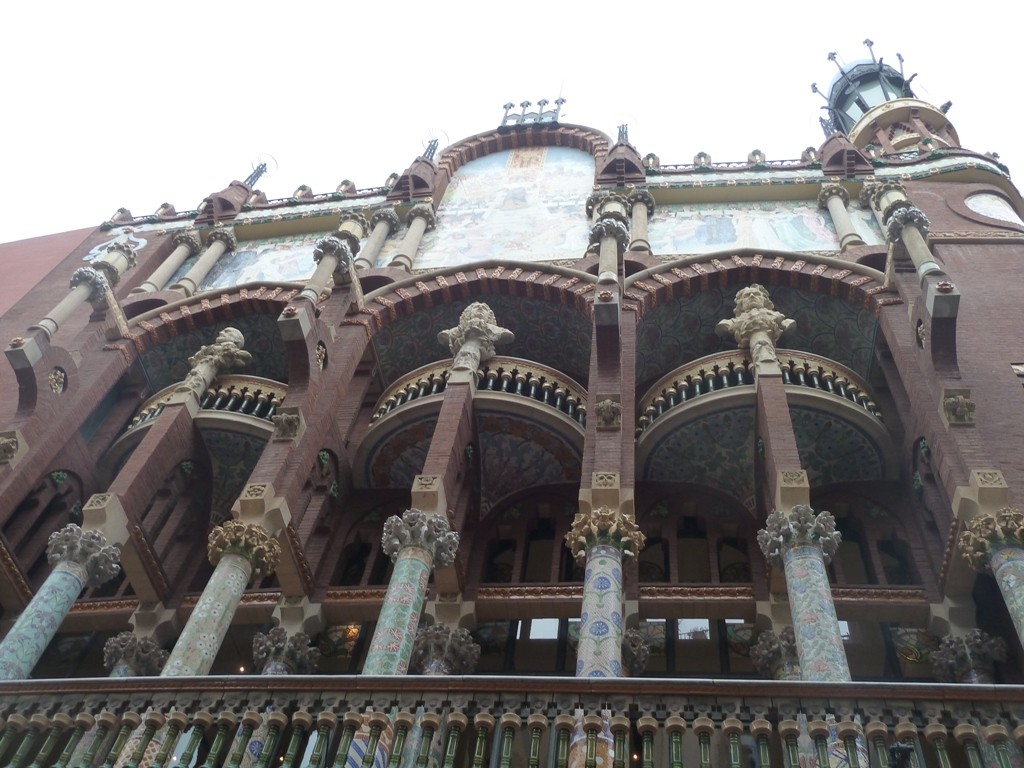This district, officially called "Sant Pere, Santa Caterina i la Ribera", is doubtlessly one of the most fascinating areas of Barcelona. Its name is obviously due to the proximity to the sea ("Ribera" means indeed "shore"). The southern part of the district, indeed, overlooks the port area; the widest part of the district, though, is included between Parc de la Ciutadela, which marks its northern border, and Via Laietana, the large avenue which separates it from the Ciutat Vella.
The most remarkable and symbolic building in La Ribera is probably the church of Santa Maria del Mar, which I have already described in a specific entry. Although, this area also presents other interesting features which are really worth seeing. Right behind the church, the nice and lively Passeig del Born, once the main square in Barcelona, reaches out. However, it is a much narrower way, called Carrer de Montcada and originating behind the church as well, which will allow you to go through the heart of La Ribera. A fascinating medieval street, surrounded by ancient palaces dating back to the XIV and XV century, where the wealthy tradesmen used to live. A few of this buildings currently house one of the best museums in Barcelona, namely the Museu Picasso.

It must not be forgotten, indeed, that though he was born in Malaga, Andalucia, and he died in France, the great painter has lived in Barcelona for most of his youth, and spent several other periods of his life in the Catalan capital. That is why the city houses this unique museum, which despite preserving mainly paintings from the formation years of the artist, offers an extraordinary overview of Picasso's artistic production. The exposition, consisting in more than one hundreds paintings, may not include the most famous painting of the creator of Cubism, but some of the pictures on show are really wonderful, abundantly making up for the entrance fee (which by the way is not expensive at all: 11 Euros, with a reduction for students and free entrance is offered on the first Sunday of the week and every Sunday afternoon). Retrato de la tìa Pepa (Portrait of aunt Pepa) and Ciencia i caritat (Science and Charity), both painted at the age of 15, are superb examples of the precocious talent of the artist, while La dona de la cofia (Thee woman with the bonnet) is one of the most emblematic works of the so-called Blue Period. Terrats de Barcelona (Roofs of Barcelona) and El Paseo de Colon are a couple of paintings showing some enchanting perspective of the city, while the final part of the collection is devoted to that series of paintings called Las Meninas. Picasso, indeed, during the final years of his life produced an incredible series of versions and reinterpretations of the masterpiece by Velazquez.
Having admired the museum, or at least the gracious palaces which house it, you may go on along Carrer de Montcada. By the way, the Museu Picasso is not the only museum located in this part of the city. On the same street, indeed, the Museu d'Art Pre-Colombì (preserving a collection of jewels, sculptures and various kinds of objects from South American civilizations ), and the curious Museu del Mammut (Mammoth Museum), devoted to this mysterious (and unfortunately extinct) mammal, are also found. In the northern part of the district, not far from Parc de la Ciutadela, is situated instead the most...delicious exposition of Barcelona, namely the Museu de la Xocolata (Chocolate Museum). According to a friend who has been there, the exhibition itself is probably not worth the 6 Euros entrance fee...but the delicious bar of chocolate offered to the visitors partially makes up for it!

After crossing Carrer de la Princesa, the final (and less interesting) stretch of Carrer de Montcada will lead you to the Mercat de Santa Caterina, the main market of the district, housed in a modern spectacular building. On the southern side of the market, instead, is preserved a small archeological site, featuring the ruins of the 15th century monastery of Santa Caterina. The areas located on the northern and eastern sides of the market mainly consist in a series of narrow, quite dirty and highly populated streets. Nevertheless, the district has still a wonderful gem in store. A few blocks far from Santa Caterina, indeed, and just a few metres from Via Laietana, lies indeed the extraordinary Palau de la Musica Catalana. Designed by Domenech i Montaner and realised between 1905 and 1908, this building is one of the masterpieces of Modernism. Undoubtedly, the facade is really charming, featuring a series of sculptures and colourful mosaics, decorated capitals and superb columns. It is probably a good idea to take the due time to admire it, as it is the only part of the palace accessible to most people. The inside, indeed, though equally breathtaking, is reachable only to those taking part to a guided tour at the quite high price of 18 Euros (no reductions available). Anyway, despite having been roughly welcomed by some members of the Catalan artistic community, the palace is now universally considered a real masterpiece.

Some final words may be spent about one more interest aspect about La Ribera. In the area surrounding Santa Maria del Mar and all along Passeig del Born, indeed, some of the best restaurants in Barcelona are located. At the same time, it is also possible to find a few interesting shops, both in the above-mentioned area and along Carrer de Montcada. In a nutshell, La Ribera is a really fascinating district, offering a wide range of possibilities for cultural activities, entertainment or relax. Not surprisingly, it is usually very crowded, sometimes even more than the Ciutat Vella itself!
